What if you could cook improvise practically any dinner, with just pantry ingredients and some fresh produce? It’s absolutely possible with a well-stocked selection of vegan pantry staples.
I compiled the list of the most frequently used ingredients that go into my family’s dinners at home. Since I practically always cook from the Vegan Family Meal Plans, I created a big spreadsheet with all of the meal plan’s ingredients based on the shopping lists, then I counted the number of times each ingredient appeared. The list below contains those vegan pantry staples I use every week, plus a few that I use only occasionally – but at least once per season. They are all either non-perishable, or stable when refrigerated. If you stock most of the vegan pantry staples from this list, you will not only be able to cook practically all meals from the Vegan Family Meal Plans, but also improvise dinner when you need to.
On occasion, you may hit a recipe for which you are missing an ingredient or two. In 99% of cases, the missing ingredient can be replaced with one of those you already have in your vegan pantry. If you need suggestions for substitutions, do not hesitate to ask in the comments below this article.
All these vegan pantry staples are plant-based – except mushrooms (which are fungi) and salt (which is a mineral). For the most part, those ingredients are also whole, or minimally transformed. Whenever possible and reasonable, the best practice is to purchase those ingredients in bulk and then transfer them to your own clear glass containers with airtight lids – my recommended way to protect your food inventory against pantry moths, avoid food waste, and speed up cooking.
Vegan pantry staples can be divided among less than just a few categories: legumes, grains and pseudo-grain and their products, nuts and seeds, spices and flavorings, and canned goods, in addition to a small number of miscellaneous shelf-stable and refrigerated items.
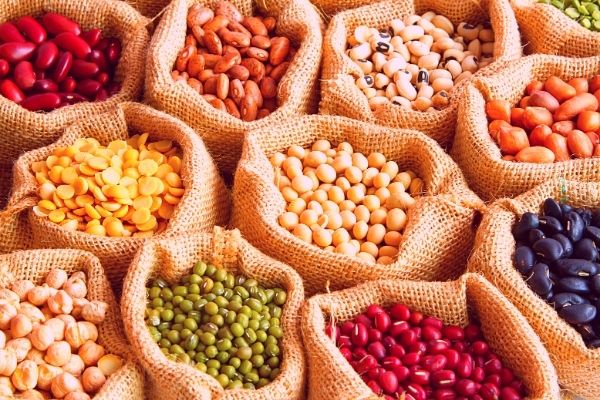
All the legumes: pillars of plant-based eating
The following pulses show up on our table every month, and in some cases every week:
- Chickpeas: our everyday favorite.
- Black beans: a very close second.
- White/cannellini beans: perfect on its own, but also great to add nourishment and thickness to soups.
- Red lentils: add them to everything, you won’t even know they are there. (One of my favorite nutrition hacks.)
- Green or brown lentils: excellent as a base for burgers and neatballs.
- French “de Puy” lentils: more firm and suitable for bowls and salads.
- Yellow split peas: great in soups and stews.
- Black-eyed peas: when you can’t decide between a black bean and a cannellini…
I prefer cooking my beans from dry, but canned beans are perfectly acceptable too. (If you find BPA-free cans, even better.) Every Friday, immediately after reviewing the coming week’s meal plan, I pull the dry beans I’ll need from the pantry and soak the required quantities, plus more for lunches and snacks. Saturday morning, I drain the soaked beans and cook them in my Instant Pot.
There are some beans I use only occasionally, like kidney, lima, and pinto, so I tend to buy them canned if they make an appearance on the meal plan (or substitute for a dry bean I have on hand).
Grains and pseudo-grains: carbs are good for us
The grain-free diet fad is one I just can’t get behind or even understand. Carbohydrates are humans’ primary source of energy and grains are a great source of carbs. Within this general category, it is wise to choose ingredients that also bring other nutritional value, such as a wealth of fiber and vitamins that nurture a healthy heart and digestive system. Here are my favorites:
- Brown and red rice (but please cook it like pasta to get rid of the arsenic)
- Quinoa
- Farro
- Wheatberries
- Barley (pot is closer to whole but pearl cooks faster)
- Rolled oats
Millet isn’t featured on this list because I haven’t eaten much of it in the past, but I’m working on adding more of it to our meals as a substitute for rice. Like quinoa and farro, it makes a great building block for bowls.
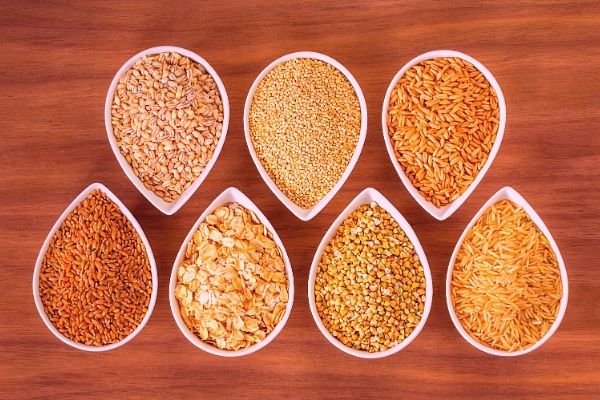
Some convenient and delicious, but lightly processed, grain products
Although I agree in theory that it is preferable to populate our meal plans with whole grains, as opposed to flour-based products, I still need the convenience of some lightly processed grain products to enable my cooking goals. If you are trying to reduce your weight for health reasons, I’d recommend engaging with the material in the How Not to Diet book and de-flouring your diet. If you are at a healthy weight, enjoying these shortcuts a few times per week seems like a reasonable practice, as long as you also consume a lot of whole grains and vegetables.
- Pasta: I always stock some long, quick-cooking ones (spaghettini) and a couple of varieties of short ones. Try as I might, I can’t enjoy whole wheat version, but if you do, it’s recommended.
- Asian noodles: buckwheat (soba) and rice noodles are our favorites but when I visit a Korean grocer I love buying some bean- and yam-based noodles too, and use all of those interchangeably.
- Couscous (preferably whole wheat): cooks in 5 minutes all included, can’t be beat for speed!
- Gnocchi: these pillow-like potato dumplings make a weeknight dinner feel like a special occasion.
- Arborio rice: makes the creamiest risottos!
- Whole wheat and all-purpose flour: I combine these two to make pizza (1/3 whole wheat, 2/3 all purpose) about once per month.
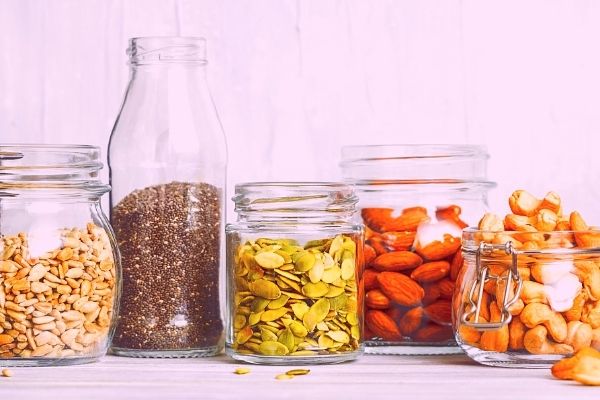
Nuts, seeds, and dried fruit
Every meal can benefit from a sprinkle of nuts and seeds. They impart a contrast in texture and color, in addition to their many nutrients. Dried fruit add sweetness (and iron!) to bowls and even to some stews without having to chop anything.
- Almonds
- Walnuts
- Cashews
- Sesame seeds (and tahini, which is sesame seed butter)
- Sunflower seeds
- Hemp seeds
- Pumpkin seeds
- Flax seeds (whole, plus a small, separate jar with a week’s worth of ground flax seeds to make it easy to sprinkle it everywhere)
- Raisins, currants, and cranberries
- Dates (added to blended sauces instead of a sweetener)
Whenever a dish calls for nut or seed butter, I just throw the whole version in the blender. If you do not have a high-power blender, you may want to stock almond butter and maybe pumpkin butter.
The ingredients above are those I use for dinner. To cover for snacks and breakfasts (and in particular my favorite morning meal: overnight oats), I would add the following:
- peanuts
- hemp seeds
- chia seeds
- prunes
- Goji berries
- Brazil nuts (just to have Dr. Greger’s 4 per month)
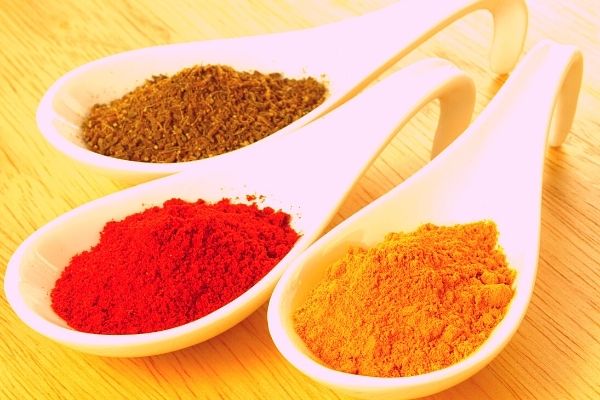
Spices for life
My favorite dishes are inspired by Mexican, Indian, and Asian cuisines. Whenever possible, I prefer to buy whole spices then grind and combine them myself, rather than buying ready-made mixes, because it decreases my odds of consuming adulterated spices spiked with fillers. (Unfortunately, fraud is extremely common in the spice industry.) Here are my favorites:
- Peppercorns
- Salt
- Cumin (I keep them both whole and ground)
- Turmeric (ground)
- Oregano
- Thyme
- Garlic powder
- Red chili flakes and chili powder
- Coriander (whole and ground)
- Smoked paprika
- Cinnamon
- Mustard powder (add a pinch when cooking cruciferous veggies!)
- Onion powder
- Rosemary
- Black salt (also known as kala namak, to add that “eggy” taste to tofu for scrambles)
- Bay leaves
Other flavorings that make a world of difference
If you think vegan food is bland, you need to up your flavoring game! (You might want to peek at my guide to vegan cooking for beginners and learn how to deglaze when making soups and stews.) In addition to the spices above, I use the following seasonings on a regular basis.
- Vegetable broth powder: I use a lot of broth, but I don’t have the space to make big batches of my own, nor the carrying capacity to bring containers of prepared broth back home, so I use a quality powdered vegetable broth instead, and dissolve it in boiling water. In addition to my everyday option, I love using Better Than Bouillon beef-less and chicken-less paste for some dishes.
- Balsamic vinegar
- Nutritional yeast flakes: for that cheesy taste
- Soy sauce (low-sodium) and/or tamari
- Apple cider vinegar
- Vegan Worcestershire sauce (the non-vegan option has anchovies…)
- Various hot sauces: my husband adds some to almost everything.
- Rice vinegar
- Truffle oil (a few drops suffice!)
- Liquid smoke
- Dried mushrooms
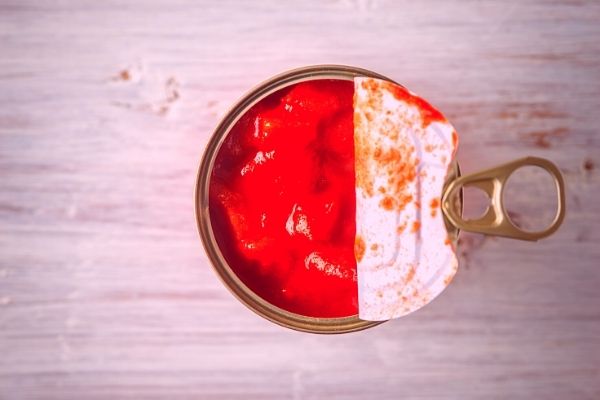
Canned goods: useful shortcuts
These simple ingredients are a must to create for a wide range of dishes, including instant sauces:
- Tomatoes in 28-ounce cans (crushed or diced)
- Tomato paste
- Tomato sauce for pizza
- Jackfruit in water or brine (NOT in syrup)
- Coconut milk: a once-in-a-while indulgence
- Roasted red peppers
- Sundried tomatoes
- Kalamata olives
Many people will add “pasta sauce” to the list here but I prefer making my own with onion, garlic, and canned tomatoes.
Miscellaneous pantry ingredients
Some ingredients just have a hard time fitting into categories:
- Kombu: added to the cooking water of beans to cover our iodine needs, since we don’t use iodized salt.
- Wakame: for miso soup and snacking.
- Arrowroot powder: as a thickener instead of cornstarch (just to avoid corn products, but really it’s not a big deal).
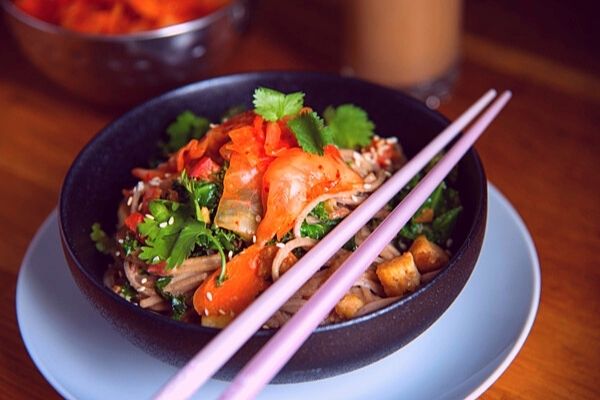
Vegan kimchi adds a punch to my favorite Friday night dinner: coco-peanut noodles, made almost entirely from pantry ingredients.
Refrigerated ingredients
These ingredients are always in my fridge:
- Lemon and lime juices: I found a brand that actually tastes like the real thing and enables me to use those more often (a natural nutrition booster) more often than I would if I had to pull out a citrus and juice it. Your mileage may vary.
- Miso paste: adds umami and saltiness to sauces (without the downsides of plain salt) and of course is essential to make miso soup.
- Tofu (firm and extra-firm): we love it for its versatility. If there is tofu in the fridge, there can be dinner on the table. (Technically, it is not stable for more than a few weeks in the refrigerator, but we eat it faster than that!)
- Basic condiments like ketchup, Dijon mustard, and vegan mayo: we use very small amounts of those, perhaps one jar of each per year for our family of four, but they are good to have on hand and never go bad.
- Kimchi (check that it has no anchovies or shrimp): enlivens any Asian dish with just a forkful.
- Active dry yeast: for monthly pizza night.
- Baking powder: used quite rarely for dinners, but keeps for a very long time in the fridge.
- Maple syrup: I’m from Québec and sometimes can’t resist adding a teaspoon to a tomato dish that turned out too acidic.
Frozen ingredients
Whenever possible, I pick fresh produce. But if using frozen veggies saves us from ordering take-out, I go for it without hesitation.
- Edamame (with and without shells): for snacking, bowls, and even pesto!
- Green peas
- Corn kernels
- Mixed veggies
- Potato wedges (for oven fries)
What about oils?
Our family is healthy with no warning signs of heart disease or chronic concerns, and we do not struggle with weight, thus I don’t feel bad using a very small quantity of oil, usually a teaspoon or two when roasting vegetables, or sautéing tofu. But they are by no means necessary vegan pantry staples so I won’t list them here.
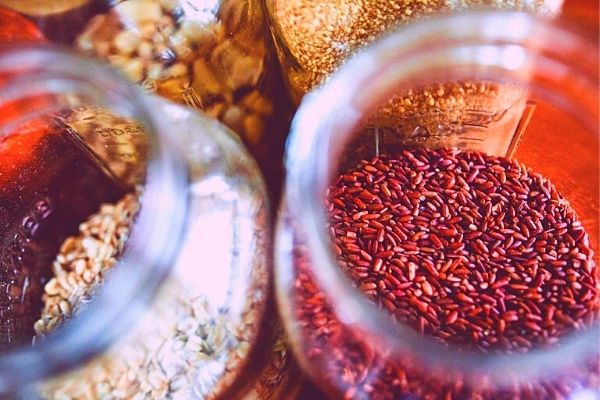
Make the most of your pantry investments
I have seen vegan shopping lists with over 300 ingredients, but my kitchen and stomach are only so big. I prefer to keep my pantry streamlined, which also helps me reduce food waste. Even long-lasting ingredients are not eternal and you should plan on having at least a once-a-year vegan pantry challenge to review and refresh your stocks.
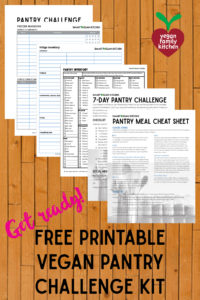
Learn more about the Vegan Pantry Challenge and get started this weekend.

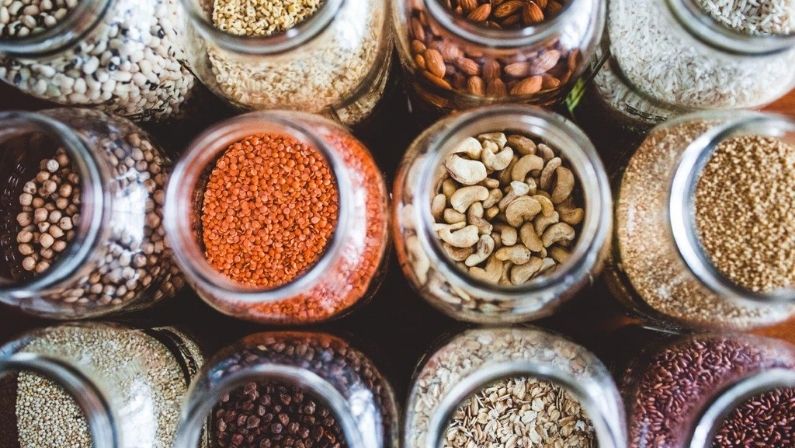
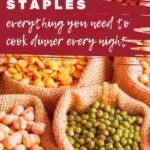

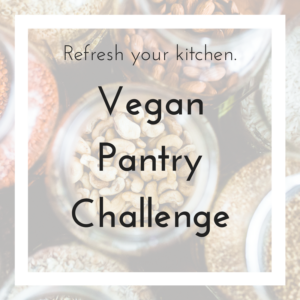
Thanks Brigitte,
Any chance you could share the brand of lemon and lime juice that you use? I would love a shortcut for that!
Hello Jackie! The one I use at the moment is Earth’s Choice – not sure if it’s available in the USA. In the past I have used Santa Cruz which I am pretty sure you can find at Whole Foods.